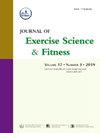Enhancing cognitive function through blood flow restriction: An effective resistance exercise modality for middle-aged women
IF 2.4
2区 医学
Q2 SPORT SCIENCES
引用次数: 0
Abstract
Purpose
Cognitive decline progresses more rapidly in women than in men, with a higher prevalence of neurodegenerative diseases observed in females. Exercise has been shown to enhance cognitive function through the upregulation of neurotrophic factors such as brain-derived neurotrophic factor (BDNF), vascular endothelial growth factor (VEGF) and insulin-like growth factor-1 (IGF-1). However, high-load resistance exercise may not be suitable for all populations, particularly middle-aged women. Low-load resistance exercise with blood flow restriction (LLBFR) has emerged as an effective alternative. This study investigated the acute effects of LLBFR on neurotrophic factors and cognitive function in middle-aged women.
Methods
Fifteen healthy middle-aged women completed a randomized crossover trial involving four conditions: control (CON), low-load resistance exercise (LLRE), LLBFR, and moderate-load resistance exercise (MLRE). Cognitive function was assessed before and after each session using the color-word matching Stroop task (CWST). Blood samples were analyzed for serum levels of BDNF, VEGF, and IGF-1, and lactate concentrations were measured to evaluate metabolic responses.
Results
Only the LLBFR condition showed significant improvements in CWST reaction time (p = 0.002) with no changes in error rates, indicating enhanced cognitive performance. Serum BDNF and VEGF levels increased significantly following both LLBFR (p < 0.001, p = 0.014, respectively) and MLRE (p < 0.001, p = 0.004, respectively), whereas IGF-1 levels remained unchanged across conditions. Increases in lactate concentrations were positively correlated with changes in BDNF and VEGF (p < 0.001 for both), but not with IGF-1.
Conclusion
A single session of LLBFR improved cognitive function and upregulated neurotrophic factors, particularly BDNF and VEGF, in middle-aged women. These findings suggest that LLBFR may be an effective intervention for promoting cognitive health in this population.
通过限制血流增强认知功能:一种有效的中年妇女抗阻运动方式
目的:女性认知能力下降的进展比男性更快,女性神经退行性疾病的患病率更高。运动已被证明可以通过上调脑源性神经营养因子(BDNF)、血管内皮生长因子(VEGF)和胰岛素样生长因子-1 (IGF-1)等神经营养因子来增强认知功能。然而,高负荷阻力运动可能并不适合所有人群,尤其是中年女性。低负荷阻力运动与血流限制(LLBFR)已成为一种有效的替代方案。本研究探讨了LLBFR对中年妇女神经营养因子和认知功能的急性影响。方法15名健康中年妇女完成了一项随机交叉试验,包括4种条件:对照组(CON)、低负荷阻力运动(LLRE)、低负荷阻力运动(llfr)和中负荷阻力运动(MLRE)。认知功能在每次会话前后使用色词匹配Stroop任务(CWST)进行评估。分析血液样本的血清BDNF、VEGF和IGF-1水平,并测量乳酸浓度以评估代谢反应。结果只有LLBFR组在CWST反应时间上有显著改善(p = 0.002),而错误率没有变化,表明认知能力有所提高。在LLBFR (p < 0.001, p = 0.014)和MLRE (p < 0.001, p = 0.004)后,血清BDNF和VEGF水平均显著升高,而IGF-1水平在各条件下保持不变。乳酸浓度的增加与BDNF和VEGF的变化呈正相关(两者p <; 0.001),但与IGF-1无关。结论:单次LLBFR可改善中年妇女的认知功能,上调神经营养因子,特别是BDNF和VEGF。这些发现表明,LLBFR可能是促进这一人群认知健康的有效干预措施。
本文章由计算机程序翻译,如有差异,请以英文原文为准。
求助全文
约1分钟内获得全文
求助全文
来源期刊
CiteScore
5.10
自引率
3.60%
发文量
54
审稿时长
31 days
期刊介绍:
The Journal of Exercise Science and Fitness is the official peer-reviewed journal of The Society of Chinese Scholars on Exercise Physiology and Fitness (SCSEPF), the Physical Fitness Association of Hong Kong, China (HKPFA), and the Hong Kong Association of Sports Medicine and Sports Science (HKASMSS). It is published twice a year, in June and December, by Elsevier.
The Journal accepts original investigations, comprehensive reviews, case studies and short communications on current topics in exercise science, physical fitness and physical education.

 求助内容:
求助内容: 应助结果提醒方式:
应助结果提醒方式:


